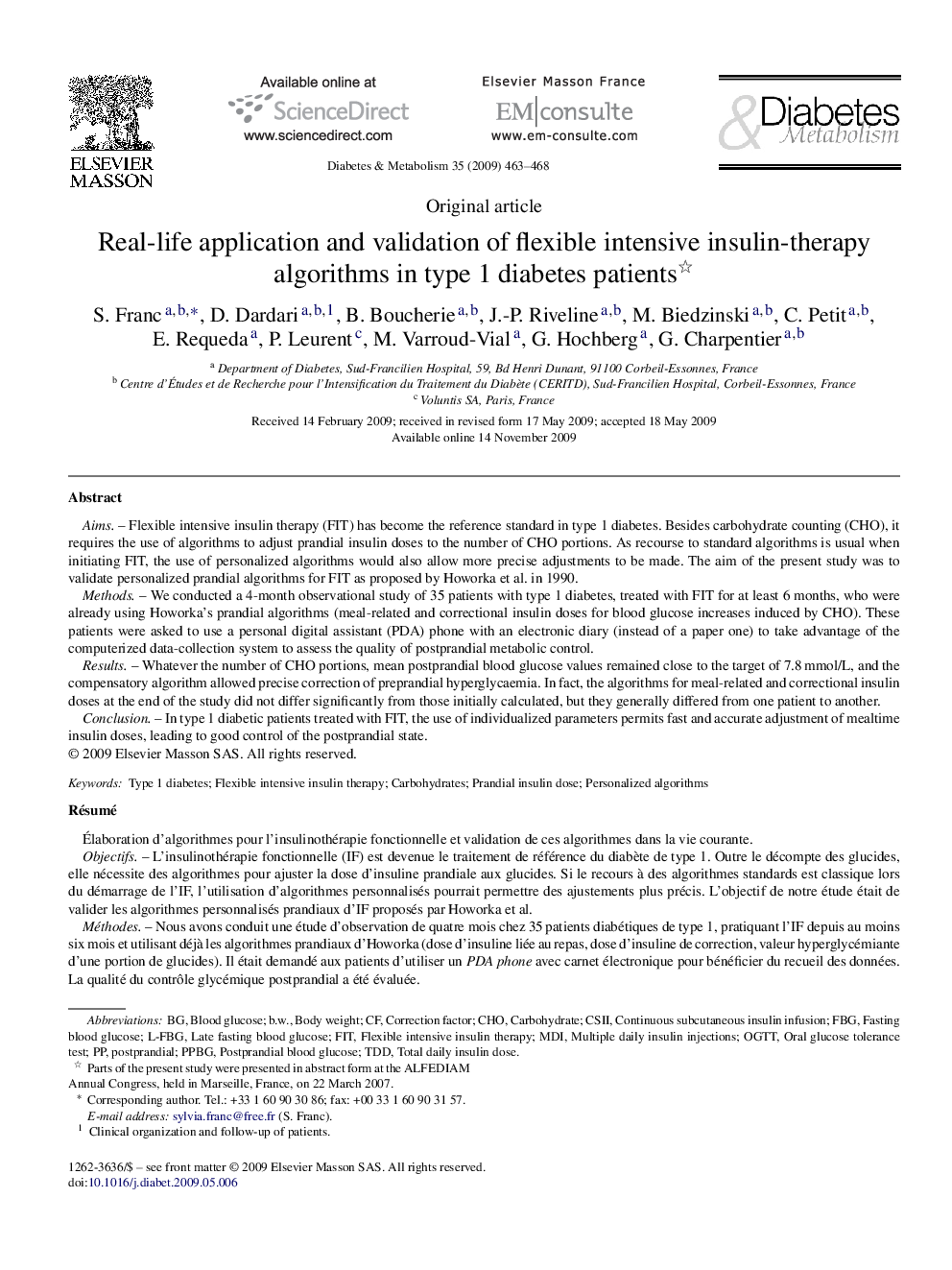| کد مقاله | کد نشریه | سال انتشار | مقاله انگلیسی | نسخه تمام متن |
|---|---|---|---|---|
| 3260339 | 1207616 | 2009 | 6 صفحه PDF | دانلود رایگان |

AimsFlexible intensive insulin therapy (FIT) has become the reference standard in type 1 diabetes. Besides carbohydrate counting (CHO), it requires the use of algorithms to adjust prandial insulin doses to the number of CHO portions. As recourse to standard algorithms is usual when initiating FIT, the use of personalized algorithms would also allow more precise adjustments to be made. The aim of the present study was to validate personalized prandial algorithms for FIT as proposed by Howorka et al. in 1990.MethodsWe conducted a 4-month observational study of 35 patients with type 1 diabetes, treated with FIT for at least 6 months, who were already using Howorka's prandial algorithms (meal-related and correctional insulin doses for blood glucose increases induced by CHO). These patients were asked to use a personal digital assistant (PDA) phone with an electronic diary (instead of a paper one) to take advantage of the computerized data-collection system to assess the quality of postprandial metabolic control.ResultsWhatever the number of CHO portions, mean postprandial blood glucose values remained close to the target of 7.8 mmol/L, and the compensatory algorithm allowed precise correction of preprandial hyperglycaemia. In fact, the algorithms for meal-related and correctional insulin doses at the end of the study did not differ significantly from those initially calculated, but they generally differed from one patient to another.ConclusionIn type 1 diabetic patients treated with FIT, the use of individualized parameters permits fast and accurate adjustment of mealtime insulin doses, leading to good control of the postprandial state.
RésuméObjectifsL’insulinothérapie fonctionnelle (IF) est devenue le traitement de référence du diabète de type 1. Outre le décompte des glucides, elle nécessite des algorithmes pour ajuster la dose d’insuline prandiale aux glucides. Si le recours à des algorithmes standards est classique lors du démarrage de l’IF, l’utilisation d’algorithmes personnalisés pourrait permettre des ajustements plus précis. L’objectif de notre étude était de valider les algorithmes personnalisés prandiaux d’IF proposés par Howorka et al.MéthodesNous avons conduit une étude d’observation de quatre mois chez 35 patients diabétiques de type 1, pratiquant l’IF depuis au moins six mois et utilisant déjà les algorithmes prandiaux d’Howorka (dose d’insuline liée au repas, dose d’insuline de correction, valeur hyperglycémiante d’une portion de glucides). Il était demandé aux patients d’utiliser un PDA phone avec carnet électronique pour bénéficier du recueil des données. La qualité du contrôle glycémique postprandial a été évaluée.RésultatsQuel que soit le nombre de portions de glucides, les glycémies postprandiales sont restées dans l’objectif de 7,8 mmol/L. L’algorithme de compensation a permis une correction précise en cas d’hyperglycémie préprandiale. Les algorithmes individuels de calcul de la dose d’insuline liée au repas et de la dose de correction étaient comparables entre le début et la fin de l’étude ; ils différaient en revanche largement d’un individu à un autre.ConclusionChez les patients diabétiques de type 1 traités par IF, l’utilisation de paramètres individualisés permet des ajustements rapides et précis des doses d’insuline prandiale, permettant un bon contrôle de l’état postprandial.
Journal: Diabetes & Metabolism - Volume 35, Issue 6, December 2009, Pages 463–468